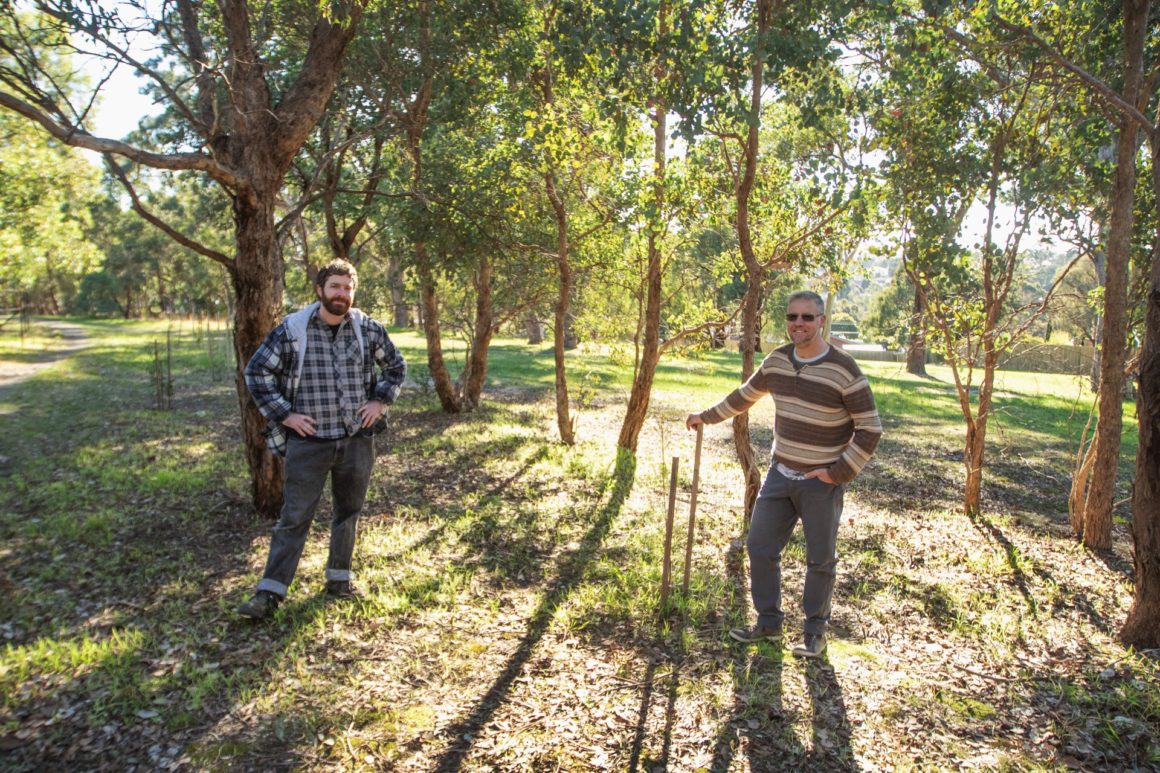Located in the leafy north-eastern suburb of St Helena, Anthony Beale Reserve is a place steeped in history. Now cared for by the recently formed Friends of Anthony Beale Reserve, it is a green space that harbours an incredible diversity of native plants , as well as many opportunities for locals and visitors to conserve a unique habitat.
As one of the dedicated volunteers of Friends of Anthony Beale Reserve, Mark is well aware of the many fascinating details of this area’s recent history. ‘Anthony Beale was the chap who settled the area with his family in the early 1840s. They had originally come from inner Melbourne and shifted the whole homestead here,’ Mark explains. ‘The suburb of St Helena got its name from [this] homestead , which was named after the island of Saint Helena where Anthony Beale was born and worked.’
The section of the reserve that the Friends now work on was ‘…bequeathed to the Council at some point many decades ago,’ Mark says. ‘It was saved from development.’
So why start this group in the first place if the area was already protected? As is the case with many founders of Friends groups, Mark is local to the area and has spent many hours enjoying the nature of the reserve. However, as the years went on, Mark noticed a gradual degradation of the indigenous understorey in the bushland. ‘What you find with these small patches in suburbia is that they can become a bit tokenistic,’ he says. ‘Over time they just slowly degrade without people noticing. Suddenly, you’ve only got half the species existing that used to be here.’

This revelation led Mark and another local, John, to form Friends of Anthony Beale Reserve in late 2015. ‘The environment’s my passion,’ Mark says. ‘I’ve always wanted to do something in my own patch, leave a bit of a legacy, show a good example.’ There is no doubt that this is what he and other members of the Friends group are currently working towards.
One major focus of the Friends’ work is biodiversity, so that the wonderful understorey that attracted Mark to the reserve in the first place is sustained. ‘When people think of bushland spaces, they think of trees – they forget about the understorey,’ Mark says. ‘And the understorey is where a lot of the biodiversity is happening. This is what makes this reserve a little bit special. There’s a huge suite of wildflowers too, and they bring in insects and other animals too. That’s one element that we like to educate people on.’ The group has also recently installed nestboxes around the reserve, which they hope will soon house a range of animals from Sugar Gliders and Ringtail Possums to microbats and any number of native bird species that call the area home.
The nestboxes are an example of how a Friends group can work closely with council to see results. ‘Council put them up after we constructed them,’ Mark says. Council and the Friends regularly check the boxes for inhabitants using a special camera – something that the entire group appears to look forward to, crowding around the screen to see who might be inside.

What stands out about Friends of Anthony Beale Reserve is the range of people involved. ‘Often Friends groups… have a whole bunch of retirees and often when those people are not active in the group anymore there’s usually very few people to replace them,’ Mark says. ‘It’s nice to see some young people and some kids with this group.’ Although there are younger members of Friends of Anthony Beale Reserve, Mark is still aware that others will need to take up the regular responsibility of caring for the area when he leaves.
It’s also not just locals who are involved. Tim, the team leader, doesn’t live close by, but is hoping to ‘start up my own Friends group somewhere closer to my house.’ Experiencing how the young Friends of Anthony Beale Reserve functions and works with Banyule Council is an important learning opportunity for him.
The fervour with which the Friends approach their work is commendable, planting and weeding in rain, hail or shine. Regular volunteer Charlie admits that he’s ‘a bit of a greenie.’ To him, the reserve is a patch of bushland that makes all the difference to the quality of living in the area: ‘I think everyone should be able to live next to a green wedge area. It’s good for your mental health, it’s good for everything.’ A retiree, Charlie believes that ‘one of the worst things about people retiring is that they start to die, when in reality you should start to live.’ To him and others involved with Friends of Anthony Beale Reserve, part of living means giving back to community and forming bonds with the land to conserve it for future generations.

Group member Marilyn describes the idea of the local as a key component of what the Friends do. ‘Because it’s local, it’s part of our heritage, it’s part of my heritage, it’s part of my kids’ heritage,’ she says. ‘It’s doing something about [connecting] some part of our urban life with a little bit of what it was like in the beginning.’ Marilyn’s granddaughter, Layla, also gets involved with the planting and weeding, explaining that ‘We can see all the beautiful plants… We can see how much they’ve grown.’ This is a rewarding feeling shared by all who give their time to the reserve, representing the resoluteness of a young Friends group that will no doubt continue to thrive into the future.
Friends of Anthony Beale Reserve meets on the fourth Sunday of every month from 10am to 12pm from March to November. Find them on Facebook for more information.
This story was originally featured in the Banyule Community Conservationists magazine published by Remember The Wild and supported by Banyule City Council. You can view the magazine in full here.
Banner image courtesy of Caleb McElrea.


Leave a Reply